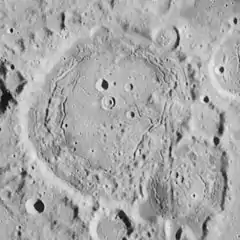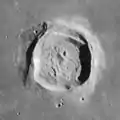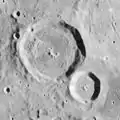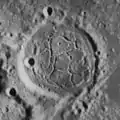 Lavoisier at center, Lavoisier F in lower right. Lunar Orbiter 4 image. | |
| Coordinates | 38°12′N 81°12′W / 38.2°N 81.2°W |
|---|---|
| Diameter | 70 km |
| Depth | 2.0 km |
| Colongitude | 82° at sunrise |
| Eponym | Antoine L. Lavoisier |
Lavoisier is a lunar impact crater that is located near the northwestern limb of the Moon, at the western edge of the Oceanus Procellarum. It is named after the French chemist Antoine Lavoisier. It is located to the southwest of the crater von Braun and southeast of Bunsen. Due south of Lavoisier is the disintegrated crater Ulugh Beigh.
This is a worn crater formation with several small craters attached to the exterior of the rim. Lavoisier F is a distorted crater that shares a common rim along the southeastern side of Lavoisier. The southern rim is extended outward, and is overlaid by the small crater Lavoisier W. Lavoisier S is a worn crater that is attached to the northwestern rim. There are also a pair of small craters along the outer eastern rim. A small crater has incised a short section along the northern rim.
The interior of this floor-fractured crater is notable for the curving ridge that parallels the northwestern inner wall. The remainder of this circular form can be traced out across the interior by an intermittent pattern of lower-albedo surface that is concentric with the inner wall. There are also several rilles marking the interior surface, particularly along the outer edges. In the northern center of the floor is a triplet of small craterlets. Several other tiny craters mark the interior surface.
Satellite craters
By convention these features are identified on lunar maps by placing the letter on the side of the crater midpoint that is closest to Lavoisier.
| Lavoisier | Latitude | Longitude | Diameter |
|---|---|---|---|
| A | 36.9° N | 73.2° W | 28 km |
| B | 39.8° N | 79.7° W | 25 km |
| C | 35.8° N | 76.7° W | 35 km |
| E | 40.9° N | 80.4° W | 49 km |
| F | 37.1° N | 80.5° W | 33 km |
| G | 37.3° N | 85.7° W | 19 km |
| H | 38.3° N | 78.8° W | 29 km |
| J | 37.5° N | 86.5° W | 22 km |
| K | 39.7° N | 74.4° W | 7 km |
| L | 39.7° N | 75.0° W | 6 km |
| N | 41.9° N | 82.4° W | 24 km |
| S | 39.1° N | 83.1° W | 24 km |
| T | 36.5° N | 76.6° W | 19 km |
| W | 36.9° N | 81.8° W | 16 km |
| Z | 36.1° N | 86.2° W | 12 km |
The following craters have been renamed by the IAU.
- Lavoisier D — See von Braun (crater).
 Lavoisier A, east of Lavoisier
Lavoisier A, east of Lavoisier Lavoisier B (smaller) and E (larger) craters, north of Lavoisier
Lavoisier B (smaller) and E (larger) craters, north of Lavoisier Lavoisier C (larger) and T (smaller) east of Lavoisier
Lavoisier C (larger) and T (smaller) east of Lavoisier Lavoisier H, east of Lavoisier
Lavoisier H, east of Lavoisier
References
- Wood, Chuck (November 12, 2006). "Wreath of Rilles". Lunar Photo of the Day. Retrieved 2015-11-11.
- Andersson, L. E.; Whitaker, E. A. (1982). NASA Catalogue of Lunar Nomenclature. NASA RP-1097.
- Blue, Jennifer (July 25, 2007). "Gazetteer of Planetary Nomenclature". USGS. Retrieved 2007-08-05.
- Bussey, B.; Spudis, P. (2004). The Clementine Atlas of the Moon. New York: Cambridge University Press. ISBN 978-0-521-81528-4.
- Cocks, Elijah E.; Cocks, Josiah C. (1995). Who's Who on the Moon: A Biographical Dictionary of Lunar Nomenclature. Tudor Publishers. ISBN 978-0-936389-27-1.
- McDowell, Jonathan (July 15, 2007). "Lunar Nomenclature". Jonathan's Space Report. Retrieved 2007-10-24.
- Menzel, D. H.; Minnaert, M.; Levin, B.; Dollfus, A.; Bell, B. (1971). "Report on Lunar Nomenclature by the Working Group of Commission 17 of the IAU". Space Science Reviews. 12 (2): 136–186. Bibcode:1971SSRv...12..136M. doi:10.1007/BF00171763. S2CID 122125855.
- Moore, Patrick (2001). On the Moon. Sterling Publishing Co. ISBN 978-0-304-35469-6.
- Price, Fred W. (1988). The Moon Observer's Handbook. Cambridge University Press. ISBN 978-0-521-33500-3.
- Rükl, Antonín (1990). Atlas of the Moon. Kalmbach Books. ISBN 978-0-913135-17-4.
- Webb, Rev. T. W. (1962). Celestial Objects for Common Telescopes (6th revised ed.). Dover. ISBN 978-0-486-20917-3.
- Whitaker, Ewen A. (1999). Mapping and Naming the Moon. Cambridge University Press. ISBN 978-0-521-62248-6.
- Wlasuk, Peter T. (2000). Observing the Moon. Springer. ISBN 978-1-85233-193-1.
External links
- From LROC:
- Lunar Orbiter Image and Clementine Color-ratio Image from USGS Astrogeology Science Center